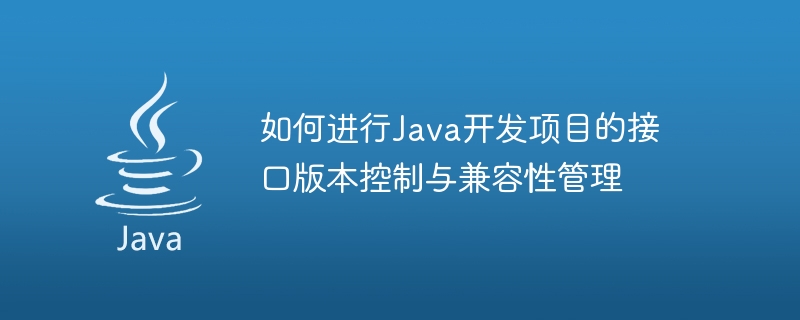
How to carry out interface version control and compatibility management of Java development projects
When carrying out Java development projects, interface version control and compatibility management are very important links . A good interface version control and compatibility management can ensure the stability and maintainability of the project and improve development efficiency. This article will introduce how to perform interface version control and compatibility management of Java development projects.
1. The importance of interface version control
The interface version is the contract for interaction between codes, which defines methods, fields and data types. In a larger project, there are often multiple different modules or services being developed at the same time. At this time, it is necessary to ensure the compatibility of the interfaces between these modules or services, otherwise integration failure will occur.
The importance of interface version control is mainly reflected in the following aspects:
- Facilitates team collaboration: In actual development, different teams may develop interfaces at the same time. Version Controls ensure smooth collaboration between teams and avoid conflicts and errors.
- Improve stability: In a project, the version number will be upgraded as the code changes. Through version control, interface changes can be tracked to ensure the stability of the project.
- Improve maintainability: Version control can record the history of code changes, which helps communication between team members and problem tracking. During the project maintenance process, problems can be better located and solved.
2. Method of interface version control
- Use version number: In the early stage of interface design, a version number must be defined, and different interface versions can be distinguished by version number. . Generally, naming methods similar to "v1" and "v2" are used to represent version numbers.
- Compatibility strategy: When the interface changes, the compatibility strategy must be clear. For example, compatibility can be maintained by adding fields or methods, and by not changing the parameters of the interface. Of course, in some cases, the version number can also be modified, but this needs to be decided based on the specific situation.
- Version control tools: In actual development, you can use version control tools, such as Git, SVN, etc., to manage different interface versions. Through version control tools, operations such as merging and conflict resolution can be easily performed to improve development efficiency.
3. Methods of compatibility management
Interface version control only solves the problem of interface version conflicts, while compatibility management is a more detailed issue. It requires that when the interface changes, it is necessary to ensure that the old version of the interface can continue to operate normally, and that the new version of the interface is compatible with the calls of the old version.
The following are some commonly used compatibility management methods:
- Downward compatibility: Try to keep the new version of the interface backward compatible with the calls of the old version. This means that callers of the old version can call the new version of the interface normally without making any modifications.
- Define compatibility testing: After the interface is changed, compatibility testing needs to be performed to ensure that the old version of the interface can continue to work normally.
- Documentation update: Clearly document the interface changes and compatibility policies to facilitate team members’ understanding and use.
- Provide a transition period: When the interface undergoes major changes, a transition period can be provided to allow callers to gradually migrate to the new interface. During this transition period, the old version of the interface will still work normally, but the new version of the interface will be clearly informed and recommended for use.
To sum up, interface version control and compatibility management are an indispensable part of Java development projects. Through reasonable version control and compatibility management, the stability and maintainability of the project can be ensured, and development efficiency can be improved. Only by paying attention to interface version control and compatibility management during the project development process can the long-term healthy development of the project be ensured.
The above is the detailed content of How to carry out interface version control and compatibility management of Java development projects. For more information, please follow other related articles on the PHP Chinese website!






